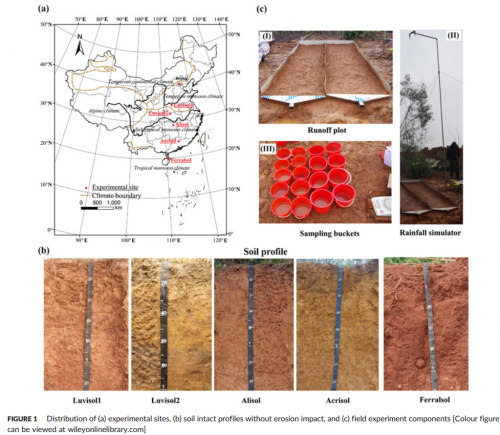
A research paper “RUSLE erodibility of heavy-textured soils as affected by soil type, erosional degradation, and rainfall intensity: A field simulation” written by the soil and water conservation and environmental ecology team of College of Resources and Environment, HZAU has recently been published online by Land Degradation and Development. The first author is doctoral candidate Wu Xinliang and the corresponding authors are Prof Cai Chongfa and Associate Prof. Wang Junguang.
It is well known that soil erosion is a serious problem world-wide for the environment or humankind, exacerbating land degradation. However, little systematic knowledge is available about the erodibility of various types of soils at different erosional degradation levels, especially at the field scale. In this research, the spatiotemporal variations of the erodibility for 5 soil types (calcic luvisol, ferric luvisol, plinthic alisol, plinthic acrisol, and acric ferralsol) from temperate to tropical climate were investigated with field rainfall simulation experiments on prewetted bare fallow heavy-textured soils (silty clay loam, silty clay, and clay) derived separately from loess deposits, quaternary red clays, and basalt. The experiments were performed in 3 erosion classes (noneroded, moderately eroded, and very severely eroded) and at 2 rainfall intensities (45 and 90 mm hr−1). Soil erodibility was represented by the K factor of the Revised Universal Soil Loss Equation. The results show that the dynamic erodibility of soil is jointly affected by rainfall intensity and soil structural stability. Soil erodibility was the lowest for the ferralsols among all the soil types and was significantly lower in the very severe than in the no or moderate erosion classes. Soil erodibility tended to be larger at the high than at the low rainfall intensity (p < .05) except for the very severely eroded luvisols, and their difference between rainfall intensities in the erodibility varied with rainfall duration. Soil erodibility could be well predicted by the combination of illite, dry aggregate stability, and amorphous aluminium oxides (adjusted R2 = .51, p < .001), and its temporal variations were significantly related with particle density, 1.4‐nm intergrade mineral, and capillary porosity (p < .05). Furthermore, soil properties selected to account for soil erodibility varied with rainfall intensity. The integrated data indicated that soil erodibility was mainly influenced by clay minerals at the region scale and soil degradation degree at the pedon scale.
It is reported that the team of soil and water conservation and environmental ecology has long established a foothold in Central China with the goal of “promoting the development of water and soil conservation and ecological construction”. The focus is on the study of the hilly areas with red soil in southern China, and the damage of soil erosion and the allocation of water resources in the sub-tropical regions. At the same time, much progress has been made in soil erosion mechanism and process simulation, impact mechanism of water and soil conservation on slope water and sediment transport, ecological function of regional landscape pattern, and soil and water conservation technology system.
Source:http://news.hzau.edu.cn/2018/0509/51899.shtml
Translated by Zhang Lei
Supervised by Zeng Wenhua